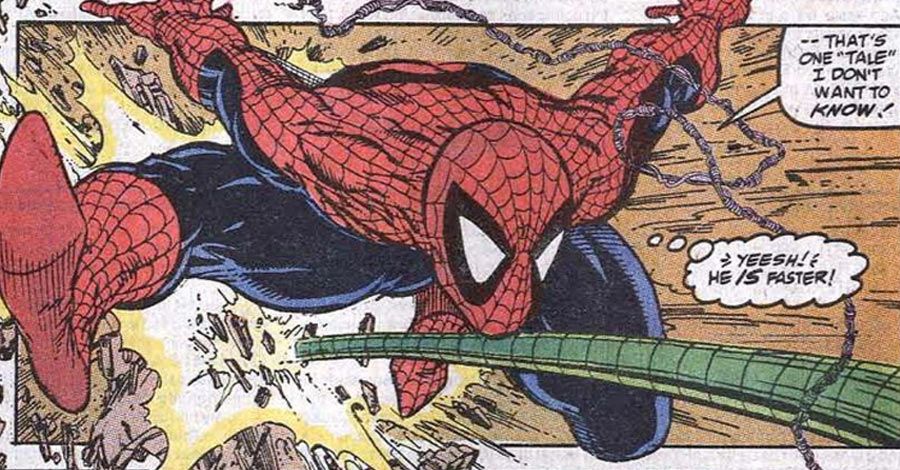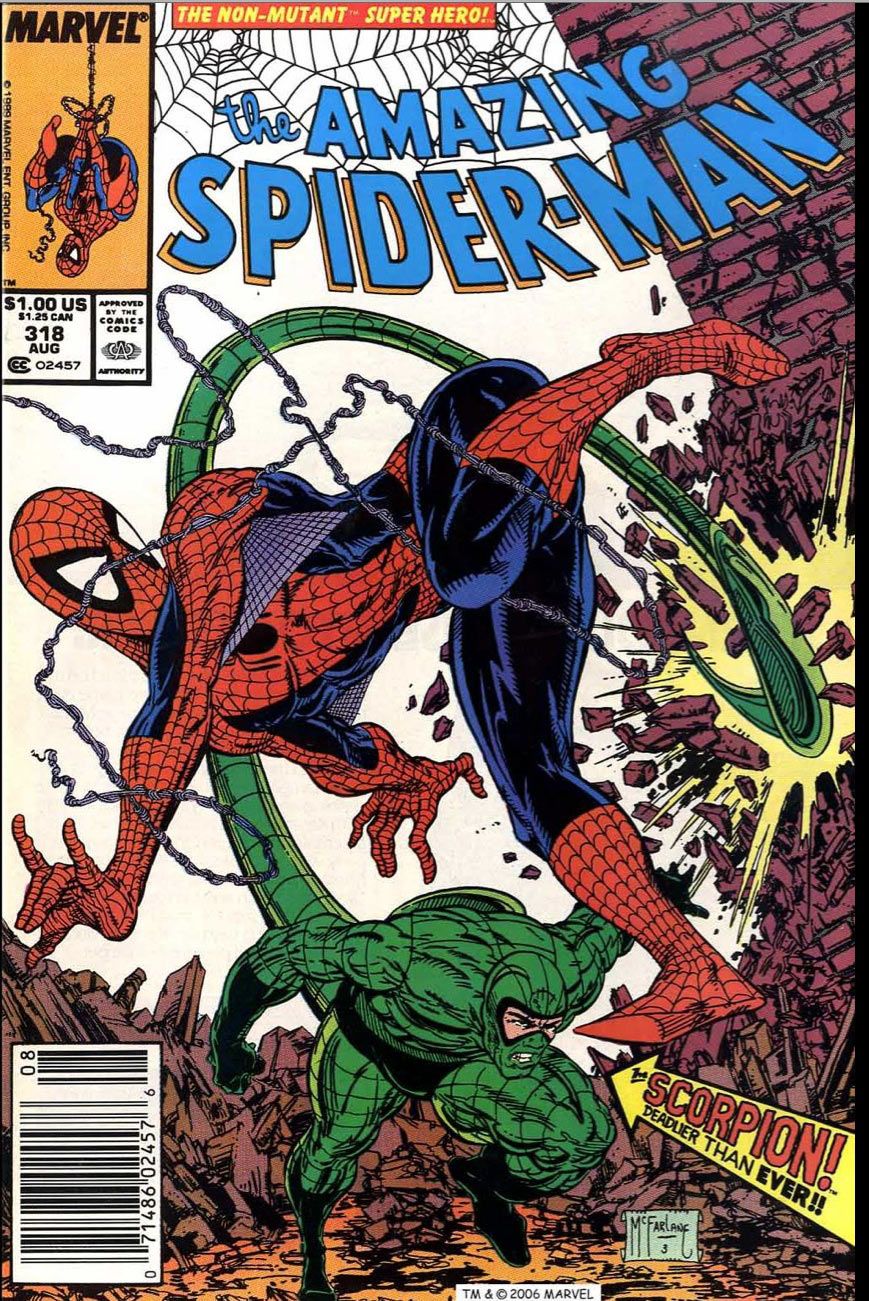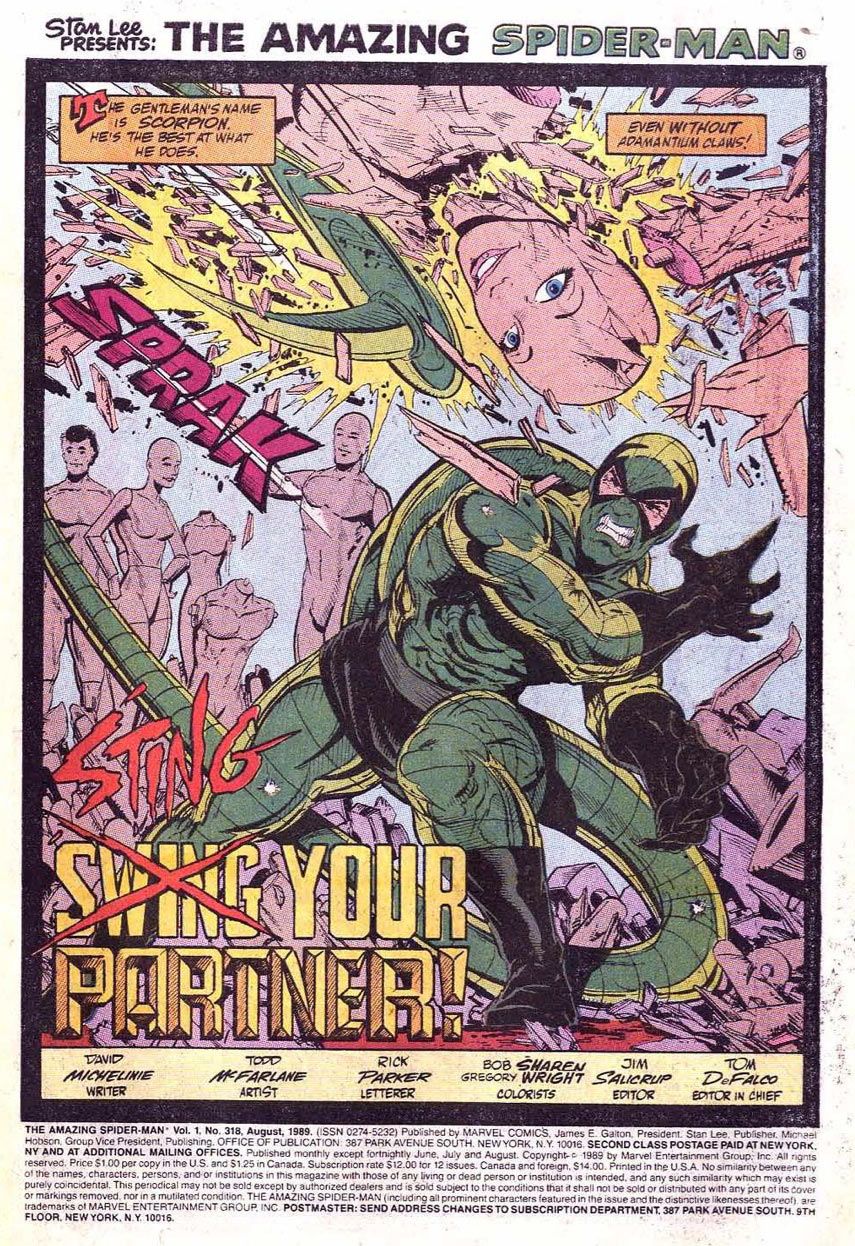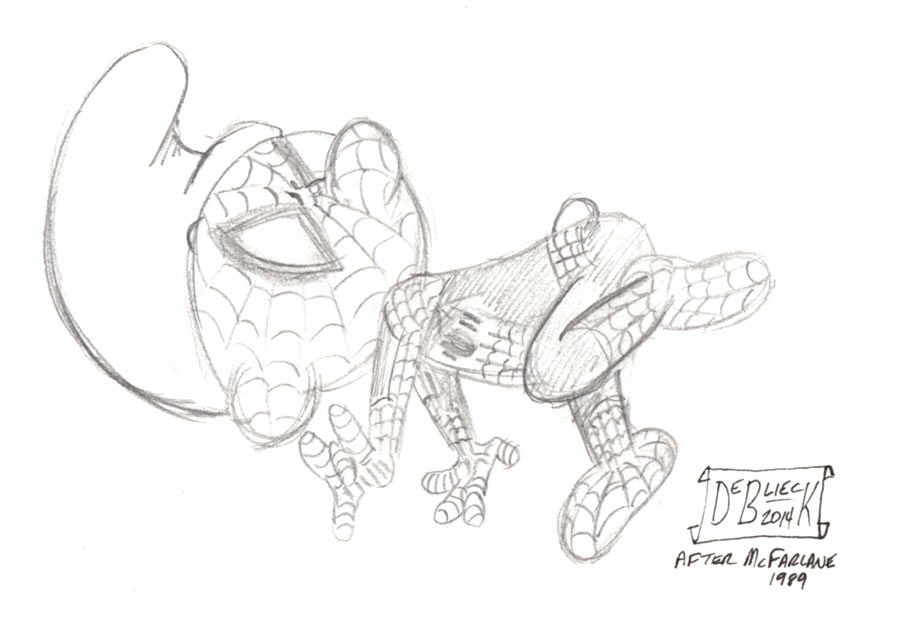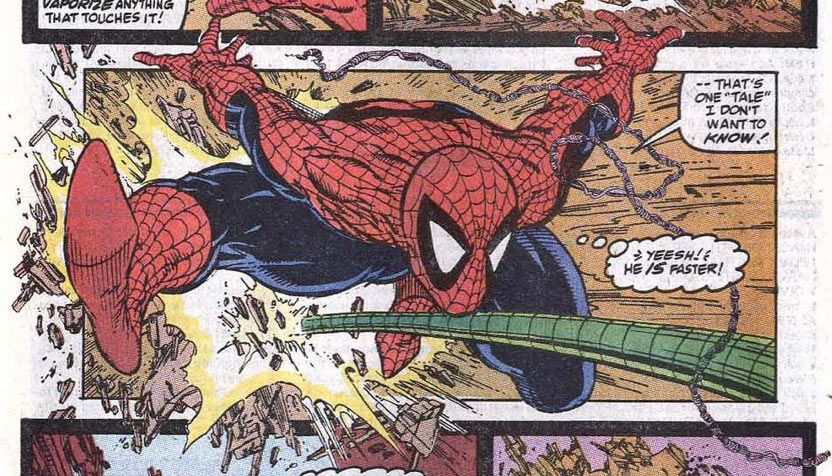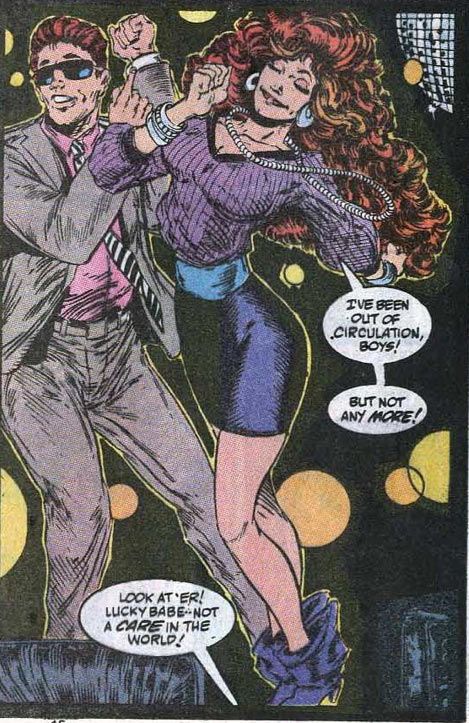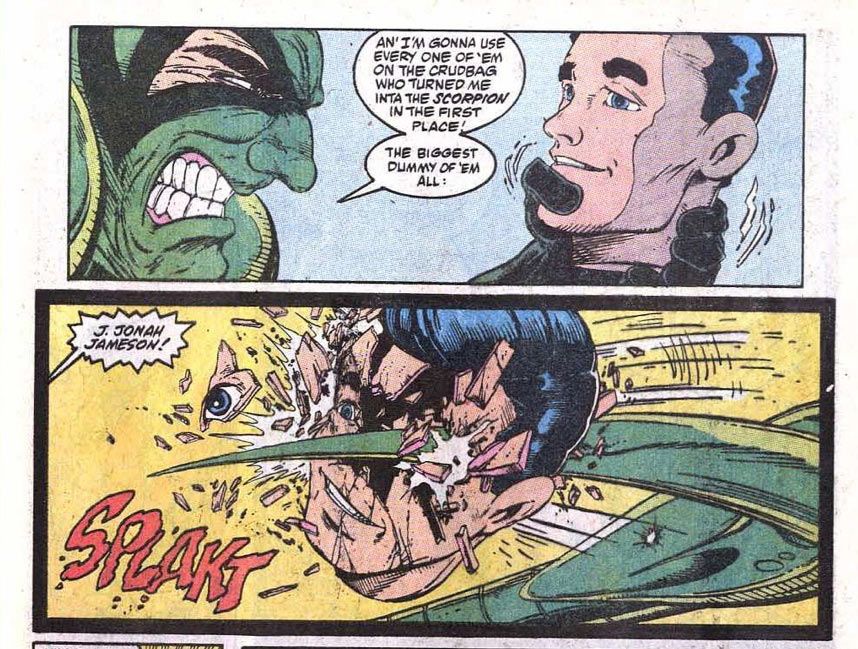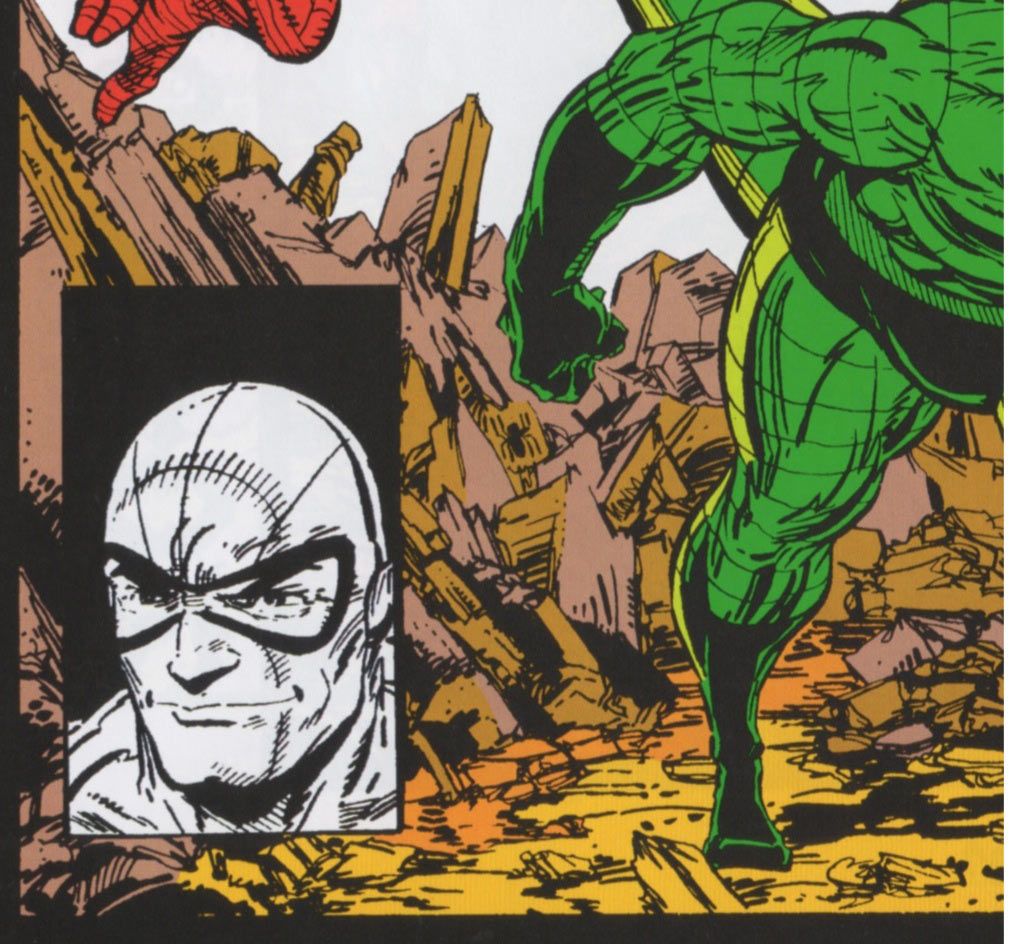"THE AMAZING SPIDER-MAN" #318: "Sting Your Partner"
Spider-Man takes on the newly-remodeled Scorpion, while Mary Jane's job woes get worse.
There are comics in everyone's collection that bring back specific memories the minute they're opened. There's a ridiculously large number of comics in my collection, for example, that I can remember reading for the first time, either in the parking lot outside the comic shop or maybe on the drive home in the earlier days when Dad would drive me to the comics shop. I can remember reading some in a friend's dorm room in college, or outside on the deck on a nice summer's night.
Then there are the comics that make you "feel" something that you can't describe. Opening its pages remind you of a specific time and place in your life. It brings back all the feelings of something that is new. You see the pages in a way that might not make logical sense; it's how you remember feeling when you first read it.
For me, "Amazing Spider-Man" #318 covers all of those bases. It was the first comic I bought when I started reading comics regularly, one spring day in 1989. I haven't stopped since, twenty-five years on.
I was 13 and spent Sunday mornings with my father, who was working in retail pharmacy. I, being a typical 13 year old boy, was miserable going to church with Mom and had started spending those morning with Dad, instead. I think I was officially done one day after Sunday School when one of the other kids threw a rock at me and hit me in the back of the head. They'd probably call that "bullying" these days. Back then, we just called it "being a jerk" and "having an idiot mother who didn't care enough."
One of my jobs when hanging out with Dad at the store was walking down to the stationery store in the same strip mall to get his Sunday newspaper. Along a long wall filled with stacks of newspapers was a newsstand of magazines and, yes, three four foot wide shelves of comics. It held mostly DC and Marvel, but with a smattering of independent fare from companies like NOW and Dark Horse and Continuity.
One week, for whatever reason, I decided to try a comic. I can't remember why anymore. I just did. I picked the coolest looking one I found, "The Amazing Spider-Man." Just look at that cover and see how cool it was.
That one random decision led to me reading a lot more Spider-Man comics, and then spreading out to other Marvel heroes books and even, eventually, that crazy world of the ultra-popular X-Men titles, filled with more characters than you could fit on a scorecard. Trust me; "Marvel Age" tried to do that.
Looking back on "Amazing Spider-Man" #318 today, it all comes flooding back to me. I didn't know anything. I didn't really even know that Peter Parker was Spider-Man, though I picked up on it quickly. It was just a cool comic. Seeing it today in the midst of these McSpidey Chronicles, I see all the on-going plot lines in motion. I see the David Michelinie formula at work. Most of the issue feels like short segments of an on-going soap opera, with a big chunk at the end reserved for the scene where Spider-Man fights the villain of the month.
Can you remember when you first read a comic and couldn't tell which characters were the major ones and which ones were minor one-offs? How was I to know that the real estate agent in the issue, Mr. Watanabe, wasn't a regular character? Who was Joy Mercado at the Daily Bugle? The Green Goblin costume shows up for a page and looks pretty cool. I would guess this was setting up next issue? (Spoiler: Far from it.)
Heck, the language of comics was new. Todd McFarlane wasn't drawing in a 2 x 3 grid style. Things are pretty straightforward in his storytelling here, but if you're one of those people prone to ask whether you should read the text before or after looking at the image, I can understand your confusion.
I cut my teeth on those kinds of questions from reading too many comic strips before this. At this point in my life, I loved drawing and thought I'd grow up to be an animator. Comic strips -- conveniently located by the busload full in every newspaper my father ever brought home -- were my training grounds. I had even attempted drawing my own by that time. So a comic book like this held little challenge.
McFarlane's art featured cartoony characters. Yes, they're drawn to look "real," but the body language and the motion that they show have a very specific accent. You could see that early on, even if you didn't real the first 20 issues of his run on the title before this. It's just the way the characters twist around, and the way those smooth lines wrap around. It's the speedlines in the background and the extreme close-ups on characters' eyes.
I have the big, heavy "Omnibus" book collecting this issue, and I also have the old CD series with scans straight off the original comics that I use for the images in this column. (The original issue is hidden in a longbox somewhere I don't have time to retrieve it from.) I usually read the modern cleaned-up "Omnibus" for the sake of the column. This week, I read the newsprint scans. It brought back more of those feelings I've been talking about for this entire column. Everything brings back memories, from the little blue bar atop every page to help the newsstand owners find the out-of-date issues, to the slight yellowing along the edges of the pages, to the way the solid black areas aren't all that solid. You can see the blocks of colors over top of them from adjacent areas.
This is a good issue for a first comic, I think. At its core, it's one hero versus one villain. The villain's motivations are clearly spelled out in the issue's opening, where he's training for the gig and then talks with his benefactor, Justin Hammer, about their deal. Everything is very expository and on the nose, but it conveys all the necessary information.
As long-time comics readers, we forget that that kind of business in a comic is necessary for first-time readers. It might be inelegant and I'm sure there are better more subtle ways, but it got the job done in a timely manner.
Todd McFarlane gets some big splashy images to draw, even when they're relatively small. It's a thrill to see his Spider-Man at work in a variety of situations, particularly when the root images are just this cool. Like I said before, I was drawing a lot back then. I think I copied every Spider-Man drawing in this comic at one point or another in the next two years. I redrew a lot of McFarlane's cooler work. Some of those drawings got taped to my bedroom wall at the time, too. They're all long gone now, but there was a time when my "recreations" (if we may be so bold to use that term) filled a wall. Honestly, I hadn't thought about that in years until today.
My early comics collection was stored in empty boxes my mother brought home from her day job working in a law firm. They once held envelopes. Now, they held the beginnings of my collection. Early on, I organized the comics by character or creator. Todd McFarlane had an early box. Ron Lim had one, too, thanks to books like "Silver Surfer" and "Captain America." I think all of DC went into another. They weren't bagged and boarded. I had no intention of hoarding another collectible item, so soon after breaking the baseball card habit, so I didn't treat them like gold.
In any case, the issue starts with the Scorpion blowing away some mannequins, using all the tools available to him in his new suit. It's kind of like a low-rent Danger Room. It makes me wonder about what kind of seed capital Justin Hammer had to fun his operations. Those mannequins cost a hundred bucks a pop at least. It's very wasteful to use them as a non-renewable resource. Hopefully, he has some other tricks up his sleeve when testing new supervillainry. Maybe he should have asked the X-Men for some help in recreating the Danger Room in exchange for a generous donation to the School for Gifted Youngsters. (Professor Xavier is such an old fuddy-duddy that he used "Youngsters" in his school name. Sheesh)
The new suit includes an acid- and gas-spewing tail, along with some super powerful wipers on his eye guards. It also includes the amazing ability to cover every inch of skin on his head, including his lips, to just let the teeth show through. It's a weird image if you stop to think about it, not that I ever suggest you do. He looks lipless in the end, but it also looks like the green from his costume is falling into his mouth. There's no barrier for entry on that.
Meanwhile, Peter and Mary Jane are looking for a new place to live. Their small budget leads to some dicey visits, and Mary Jane's constant career blocks lead her to spend her night out dancing in outrageously wide purple boots. That's how you know her career troubles are starting to impact her personal life. If that wasn't enough, she has a brief fight with Peter about it on the next page as she changes into her daintiest overnight wear. Really, it's almost scandalous for a Marvel newsstand title at the time. I bet the original art fetched a high price, though.
Eventually, we get to where Peter, dressed as Spider-Man, crashes an appearance by a military general to take pictures to sell to J. Jonah Jameson. At the same time, the Scorpion arrives to kidnap the general. Then things get complicated. To be continued...
That's the weirdest thing about the issue. It's a two-parter where the first part ends on a cliffhanger. Michelinie didn't write too many of those. On this run of the title, he stuck with mostly villains of the month. There are exceptions, specifically for Venom, but for the Scorpion?
That's it for the issue. It doesn't have too much in there worth reporting on, but as a comics newbie it was pure magic. My impatience for the next issue would lead me to sampling the other three Spider-Man titles at the time.
Months later, I would find the local comic shop and try to find back issues from McFarlane's run on the series. They were completely sold out. I settled for some "Web of Spider-Man" issues as I recall, most of which were underwhelming. But that was also the moment where I realized that Todd McFarlane was popular. There were lots of other Spider-Man back issues, but none were drawn by McFarlane -- those issues had already sold out.
I'd trade far too many other comics for a couple of those McFarlane Spider-Man issues, and I'd even buy one or two of them from back issues bins as the years went by. It wasn't until the Spider-Man CD collection came out a decade later that I'd own copies of all the issues. Now, we have the "Omnibus" book with everything plus the kitchen sink. You can't even get these issues on Comixology yet, though you can get all the Erik Larsen issues there.
"The Amazing Spider-Man" #318 will always hold a special place in my collection. Nothing can take that away. It's the reason I started this whole crazy look back at the McFarlane era of the series, but we're not done yet. At the very least, we have to see how Spider-Man can save the General and bring the Scorpion to justice. After that, Silver Sable returns, the time crunch impacts the art during the summer bi-weekly run, and Erik Larsen fills in. What fun!
Two last random bits of art:
Remember how Todd McFarlane left Marvel after having to redraw that panel where a sword went through Juggernaut's eye? It seems to be a motif in McFarlane's oeuvre. In this case, Scorpion's tail bursts through the back of a mannequin's head and out through his eye socket.
I bought all of McFarlane's "Amazing Spider-Man" issues at the newsstand, as far as I can remember. The Omnibus edition is the first time I got to see McFarlane's corner box art on the covers. There was a time until the mid to late-90s when bar codes were not the norm on comic covers. There would be a little promo image in that box or a little headshot or something the artist drew in that spot. Marvel would put in little art to celebrate a characters' anniversary otherwise. That was all true in the Direct Market. The newsstand market needed the bar codes, so they got them.
There was some angst and controversy when the ugly barcodes invaded all covers a few years later. Eventually, it all blew over, as all on-line controversies must.
CARL BARKS' COMICS PIRACY PREDICTIONS OF 1999
Carl Barks wrote a letter to Duck artist Pat Block on December 2, 1999. There's a bunch of behind-the-scenes stuff implicit in even the following paragraph, but I think it's interesting even if you don't know who Bruce Hamilton or Steve Geppi are. The last years of Barks' life could probably fill a book that would, sadly, probably have too many similarities to the last years of Groucho Marx's existence.
That said, let's get to this part:
"First, let me say I think the possibility of Bruce, Geppi and Disney ever agreeing on anything requires a whole new method of presenting comics to the buying public. The Internet web sites we have now are to[o] easily plagiarized [I think he meant 'pirated' here] to fit the ways comics were sold in the days of yore. I hope some way will open soon for you creative writers and artists and readers to return to the days of yore. Hi Tech is a pain in the neck."
Barks was both right and wrong. He wrote this letter in the age of Napster. The music industry was starting its death throes as MP3s rose up. iTunes was still a couple of years away. The world of comics had not yet become the world of rampant piracy that it would become a decade later, but it was only a matter of time. As technology got faster and better at scanning things at lower prices, piracy rates would skyrocket.
Stories used to run weekly on all the major comic websites about the role of comics piracy on the 'net. Those stories have slowed down, if not dried up, today. Whether that's because it's not news anymore and just the status quo, or because other delivery methods have curtailed piracy to such a strong degree, I do not know.
We've passed Peak Piracy Hysteria, at least.
Webcomics would become a thing not that long after Barks' letter. He's right; on-line comics required a different model. It was a serialization with ads and merchandising after the fact that made the first generation of web cartoonists so successful. People didn't pay for their comics with money, just with their eyeballs.
Years later, though, we seem to have returned to the old way. On-line comic stores sell the comics 22 pages at a time in a virtual comic book format. They're around forever and they're often on sale at far deeper discounts. Modern technology -- including but not limited to the iPad -- have made digital comics desirable.
As for a different way of reading comics? There have been plenty of experiments in the mold of "Motion Comics" in the last 15 years, though it seems Comixology's Guided View has become the gold standard in reading comics panel-by-panel. Mark Waid's Thrillbent site is doing some interesting things, too, with the way panels transition from one to the next.
Comics won't ever return to the "days of yore," but the future might just be inspired by it. You can find plenty of parallels. The good news is, it can still be done properly on the web without worrying about the piracy angle too much.
Twitter || E-mail || Instagram || Pipeline Message Board || VariousandSundry.com || AugieShoots.com || Original Art Collection || Google+

